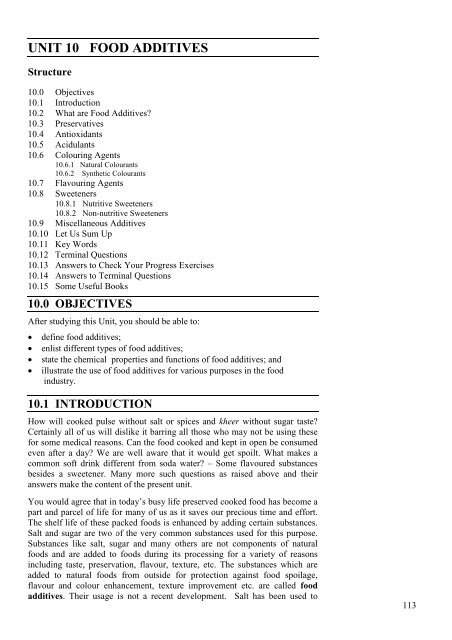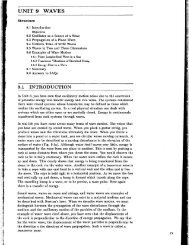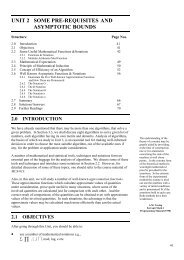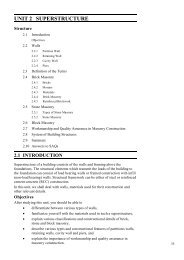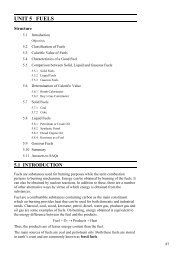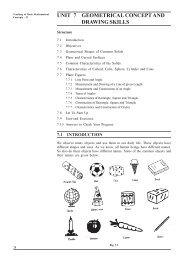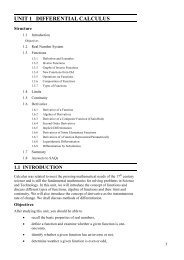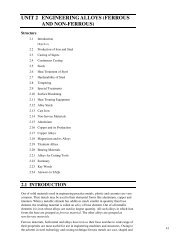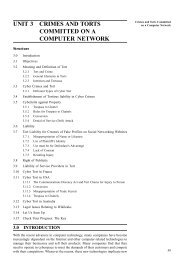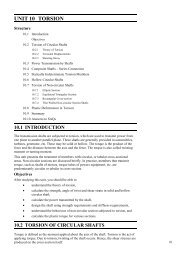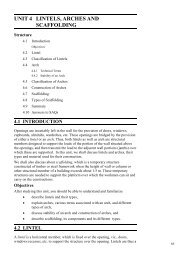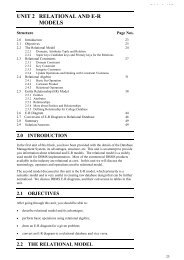UNIT 10 FOOD ADDITIVES - IGNOU
UNIT 10 FOOD ADDITIVES - IGNOU
UNIT 10 FOOD ADDITIVES - IGNOU
Create successful ePaper yourself
Turn your PDF publications into a flip-book with our unique Google optimized e-Paper software.
<strong>UNIT</strong> <strong>10</strong> <strong>FOOD</strong> <strong>ADDITIVES</strong><br />
Structure<br />
<strong>10</strong>.0 Objectives<br />
<strong>10</strong>.1 Introduction<br />
<strong>10</strong>.2 What are Food Additives?<br />
<strong>10</strong>.3 Preservatives<br />
<strong>10</strong>.4 Antioxidants<br />
<strong>10</strong>.5 Acidulants<br />
<strong>10</strong>.6 Colouring Agents<br />
<strong>10</strong>.6.1 Natural Colourants<br />
<strong>10</strong>.6.2 Synthetic Colourants<br />
<strong>10</strong>.7 Flavouring Agents<br />
<strong>10</strong>.8 Sweeteners<br />
<strong>10</strong>.8.1 Nutritive Sweeteners<br />
<strong>10</strong>.8.2 Non-nutritive Sweeteners<br />
<strong>10</strong>.9 Miscellaneous Additives<br />
<strong>10</strong>.<strong>10</strong> Let Us Sum Up<br />
<strong>10</strong>.11 Key Words<br />
<strong>10</strong>.12 Terminal Questions<br />
<strong>10</strong>.13 Answers to Check Your Progress Exercises<br />
<strong>10</strong>.14 Answers to Terminal Questions<br />
<strong>10</strong>.15 Some Useful Books<br />
<strong>10</strong>.0 OBJECTIVES<br />
After studying this Unit, you should be able to:<br />
define food additives;<br />
enlist different types of food additives;<br />
state the chemical properties and functions of food additives; and<br />
illustrate the use of food additives for various purposes in the food<br />
industry.<br />
<strong>10</strong>.1 INTRODUCTION<br />
How will cooked pulse without salt or spices and kheer without sugar taste?<br />
Certainly all of us will dislike it barring all those who may not be using these<br />
for some medical reasons. Can the food cooked and kept in open be consumed<br />
even after a day? We are well aware that it would get spoilt. What makes a<br />
common soft drink different from soda water? – Some flavoured substances<br />
besides a sweetener. Many more such questions as raised above and their<br />
answers make the content of the present unit.<br />
You would agree that in today’s busy life preserved cooked food has become a<br />
part and parcel of life for many of us as it saves our precious time and effort.<br />
The shelf life of these packed foods is enhanced by adding certain substances.<br />
Salt and sugar are two of the very common substances used for this purpose.<br />
Substances like salt, sugar and many others are not components of natural<br />
foods and are added to foods during its processing for a variety of reasons<br />
including taste, preservation, flavour, texture, etc. The substances which are<br />
added to natural foods from outside for protection against food spoilage,<br />
flavour and colour enhancement, texture improvement etc. are called food<br />
additives. Their usage is not a recent development. Salt has been used to<br />
Food Additives<br />
Food Additives<br />
113
Food Chemistry preserve meat and fish since ancient times. Spices have been employed since<br />
earliest recorded history to flavour and preserve foods. In other words, food<br />
additives seem to be a necessary part of modern society.<br />
114<br />
Though the use of food additives is well-accepted practice; there have been a<br />
number of concerns regarding the potential short-term and long-term risks of<br />
consuming these substances. These are to be used according to the regulation<br />
ascertained by Government agencies. In this unit, you will read about various<br />
types of food additives in terms of their properties, functions and importance in<br />
food industry along with the permitted additives as per the Food Adulteration<br />
Act and Rules (1954) prevalent in our country.<br />
<strong>10</strong>.2 WHAT ARE <strong>FOOD</strong> <strong>ADDITIVES</strong>?<br />
Food additives are the substances which are added to natural foods at various<br />
stages of food production, processing, storage, packing and preservation.<br />
According to the Food and Agriculture Organisation (FAO) and World Health<br />
Organisation (WHO),<br />
The food additives are the non-nutritive substances added to foods, in<br />
small qualities, to improve its flavour, texture, appearance and storage<br />
properties.<br />
According to another widely accepted definition,<br />
Food additive is a substance or a mixture of substances, other than the<br />
natural foods which is present in food as a result of any aspect of<br />
production processing, storage or packing.”<br />
As you know, the preservation of food has an age old tradition and a number of<br />
substances e.g., smoke, alcohol, spices, sugar vinegar and salt etc. have been<br />
used for this purpose. These are not included in the list of food additives.<br />
Further, according to FAO and WHO, the nutritive substances like vitamins<br />
and minerals which are added in order to supplement and enrich the food are<br />
also excluded from the list of food additives. These organizations have<br />
formulated international standards for defining the quality of food additives,<br />
their permissible levels in foods and all other technological related issues.<br />
The above definitions do not include the substances which get added to the<br />
food in the course of their agriculture production, food processing or packing.<br />
These are called unintentional or incidental additives. These are also called<br />
chance contaminants, for example, pesticides are one such type of compounds<br />
which get added to foods unintentionally and may be hazardous to health.<br />
Many a times, insect parts, and antibiotics added to animal feeds also show up<br />
in the food.<br />
The additives which are added in the food deliberately to have a desired<br />
property and for a specific function are termed as intentional additives. Since<br />
some additives may have undesirable effects on the human health, their usage<br />
has to be controlled and one must adhere to the prescribed norms and standards<br />
while using them. Many food additives are classified as GRAS meaning<br />
‘Generally Regarded As Safe’ additives. The GRAS additives are supposed<br />
to be causing no harm for longer periods. In India the Prevention of Food<br />
Adulteration Act and Rules, 1954 are responsible for listing the additives<br />
permitted in different foods and their maximum permissible limits.<br />
If you have interest in knowing the details of the Acts and Rules regarding<br />
various food additives you can browse the web site: http:// mohfw.nic.in/pfa
The various important applications of food additives in general are:<br />
to maintain nutritional quality of food<br />
to improve the nutritional quality of food by enriching and fortifying it<br />
with vitamins and minerals. You have read about this in Unit 9<br />
to protect against microbial growth in the food e.g. use of antioxidants,<br />
antimicrobial agents etc.<br />
to impart firmness to the food<br />
to retard or speed up chemical reactions in food<br />
to enhance stability of food resulting an increase in the shelf life of foods<br />
and the reduction in wastage of food. The waste is generated both by<br />
microbial and chemical causes and can be reduced by use of antimicrobial<br />
agents and antioxidants.<br />
to make food more attractive in the form of colouring agents, flavouring<br />
agents, emulsifiers, stabilizers, thickeners, clarifiers and bleaching agents<br />
to provide aids in processing, packing and transport of food. These<br />
include acids, alkalis, buffers, sequestrants and other types of chemicals.<br />
Today, a very large number of additives are being used in food industry. On<br />
the basis of their functional properties, these can be classified into the<br />
following types.<br />
Preservatives<br />
Antioxidants<br />
Acidulants, neutralizers and buffers<br />
Colouring agents<br />
Flavouring agents<br />
Sweeteners<br />
Miscellaneous additives.<br />
In the following sections, you will read about these different types and<br />
categories of the food additives and their uses. Before proceeding further, try<br />
to answer the following questions.<br />
Check Your Progress Exercise 1<br />
Note: a) Compare your answers with those given at the end of the unit.<br />
1) Fill in the blanks with appropriate words.<br />
a) The substances which are added to natural foods during the<br />
production processing, storage or packing are called……………..<br />
b) Definition of food additives does not include the ………………<br />
added unintentionally to foods.<br />
c) …………………. and ………………….are the food additives used<br />
for maintaining the nutritional value of food.<br />
<br />
Food Additives<br />
Food Additives<br />
Sequestrant: An<br />
agent that removes<br />
ions from solution<br />
115
Food Chemistry<br />
Salt has been used as a<br />
preservative since the<br />
beginning of recorded<br />
history. Pickling of fruits<br />
and vegetables and<br />
salting of fish and meat<br />
are widely practiced<br />
116<br />
Sulphur dioxide and<br />
several sulphites<br />
have GRAS status.<br />
Generally, 1-2 % acetic<br />
acid is sufficient to<br />
inhibit most of the<br />
organisms.<br />
<strong>10</strong>.3 PRESERVATIVES<br />
You are well aware that foods are subject to spoilage due to contamination by<br />
microbes. As the contamination depends upon the temperature besides<br />
moisture as one of the factors, we have been using a conventional method of<br />
keeping the food material in the refrigerator to slow down this process.<br />
However, this method will not work when storage for a longer time is required.<br />
We may need to use some chemical preservatives for this purpose. Though a<br />
large number of preservatives are available, for economical and convenience<br />
reasons, salt, nitrites and sulphites have been in use for many years. The<br />
antimicrobial activity of sodium chloride is essentially related to its ability to<br />
reduce water activity (aw) and create unfavourable conditions for microbial<br />
growth. Further, though newer packaging techniques, processing and storage<br />
methods are available that can preserve foods without chemical preservatives,<br />
chemicals play a significant role in protecting the food supply, again for<br />
convenience and economy.<br />
On the basis of their mode of action, the preservatives can be grouped into<br />
three types. These are antimicrobials that inhibit growth of bacteria, yeasts, or<br />
molds for example sorbates that inhibit most of the species of yeasts, moulds<br />
and of some bacteria; antioxidants that slow down the air oxidation of fats and<br />
lipids that cause rancidity. For example preservatives like tertbutylhydroquinone<br />
(TBHQ), stop the chemical breakdown of food that<br />
happens in the presence of oxygen; and the third group which blocks the<br />
natural ripening and enzymatic processes in foodstuffs. For example, the<br />
browning the exposed surface of cut apple due to the enzyme phenolase can be<br />
checked by acids like citric acid and ascorbic acid (vitamin C) that inhibit the<br />
enzyme by making the pH uncomfortably low for it. Sulphur dioxide serves all<br />
the three functions, which makes it along with the related sulphites as an<br />
important constituent of a number of household products.<br />
Class I and Class II Preservatives<br />
Under the prevention of food adulteration Act (PFA) rules, 1954, preservatives<br />
are classified into Class I and Class II preservatives. Class I preservatives,<br />
also called natural preservatives include common salt, sugar, dextrose<br />
(glucose), spices, vinegar or acetic acid, honey, and vegetable oils. There is no<br />
restriction to the addition of Class I preservatives to any food. Brewed and<br />
synthetic vinegar (dilute acetic acid) are widely used as antimicrobials in<br />
vinegar pickles. Acetic acid is more effective against yeasts and bacteria than<br />
moulds. Only acetic, lactic and butyric bacteria are markedly tolerant to acetic<br />
acid. Like most of the preservatives, acetic acid is also more effective at lower<br />
pH. Sugar and spice also help in preserving foods. Like salt, sugar also acts by<br />
reducing the water activity of the medium to inhibit the growth of<br />
microorganisms. Many chemical substances in spices like terpenes have been<br />
shown to have antimicrobial properties.<br />
Class II preservatives are those which can be added in foods as specified by<br />
regulations and not otherwise. These can be added in foods as specified by<br />
regulations include, benzoic acid, sulphurous acid and their salts, nitrates,<br />
nitrites, sorbic acid and its sodium, potassium and calcium salts, lactic acid,<br />
propionic acid, sodium or calcium propionate, methyl or propyl-parahydroxy<br />
benzoic acid, sodium diacetate and sodium, potassium and calcium lactate. Of<br />
these, benzoates and sulphites are most widely used for preservation of fruit<br />
and vegetable products; however, recently sorbates have been allowed for<br />
some products.
Benzoic acid is found naturally in cranberries, plums, prunes, cinnamon,<br />
cloves and most berries. It is a strong antimycotic agent. Most yeasts and<br />
moulds can be controlled using 0.05–0.1% benzoic acid. Control of many<br />
bacteria requires much higher concentration. Due to low solubility of benzoic<br />
acid in water, sodium benzoate salt is preferred.<br />
Benzoic acid is permitted in several products like squashes, syrups, crushes,<br />
fruit juices, jams, jellies, marmalade, beverages, pickles and tomato products.<br />
Sulphur dioxide and its various salts have a long history of use dating back to<br />
the times of the ancient Greeks. They have been used extensively as<br />
antimicrobials and to prevent enzymatic and non-enzymatic browning in a<br />
variety of food products. Sulphurous acid inhibits yeasts, moulds and bacteria.<br />
Sulphur dioxide and sulphites are permitted under PFA for a number of<br />
products like fruit pulps, squashes, syrups, crushes, cordials, wines, beverages,<br />
and dehydrated fruits and vegetables. Sulphur dioxide is also used as an antibrowning<br />
agent.<br />
Sorbic acid and its sodium, potassium and calcium salts are collectively<br />
known as sorbates. Sorbic acid is present in some berries like berries of the<br />
mountain ash berry (rowanberry). These sorbates inhibit most of the species of<br />
yeasts and moulds. Several species of bacteria are also inhibited by sorbates.<br />
At present under PFA, sorbates are permitted for only a few fruit and vegetable<br />
products. They include jams, jellies, marmalades, glazed or candied fruits, fruit<br />
bars, fruit juice concentrates and prunes. Some of the other products include<br />
cheese, flour confectionary, smoked fish, preserved chapattis and fat spreads.<br />
Sorbic acid and potassium sorbate have GRAS status.<br />
Nitrites have been used in meat curing for many centuries. For meat curing,<br />
nitrite is used along with a mixture of salt, sugar, spices, and ascorbate. Nitrite<br />
contributes to the development of the characteristic colour, flavour, and texture<br />
improvement and preservative effects. Nitrite has a strong inhibitory action<br />
against Clostridium botulinum and several other micro-organisms.<br />
Antimicrobial substances (antibiotics) produced by microorganisms have<br />
been known for many years. These are the products of the defence system of<br />
the microbes themselves generated when they compete with each other for<br />
space and nutrients. Some of these, like nisin, and natamycin, the cheese<br />
preservatives called bacteriocins have been allowed in some foods only in<br />
recent years.<br />
Some other potential natural preservative sources include honey, milk, and<br />
even dried plums.<br />
Check Your Progress Exercise 2<br />
Note: a) Use the space below for your answer.<br />
b) Compare your answers with those given at the end of the unit.<br />
1) Categorise the following food additives into class I and class II<br />
preservatives.<br />
Benzoic acid, Glucose, Vegetable oils, Lactic acid, Salt, Vinegar, Sorbic<br />
acid, Honey, Propionic acid.<br />
………………………………………………………………………………..<br />
………………………………………………………………………………..<br />
………………………………………………………………………………..<br />
<br />
Food Additives<br />
Food Additives<br />
Antimycotic: An<br />
agent inhibiting the<br />
growth of fungi.<br />
Nitrites and nitrates are<br />
the food industry's<br />
primary chemical defense<br />
against the bacterium<br />
Clostridium botulinum.<br />
They also impart a pink,<br />
fresh hue to cured meat.<br />
117
Food Chemistry<br />
118<br />
Browning of cut fruits<br />
and vegetables is due to<br />
enzymatic oxidation of<br />
phenolic substances.<br />
Sequestrants combine<br />
with metals forming<br />
complexes with them and<br />
making them unavailable<br />
for other reactions. They<br />
can have antioxidant<br />
properties.<br />
<strong>10</strong>.4 ANTIOXIDANTS<br />
Lets us recall what we have learnt about autooxidation of fats and oils while<br />
studying Unit 7 on lipids. The unsaturated fatty acids in fats and oils can<br />
undergo oxidation during storage leading to the development of rancidity i.e.,<br />
the characteristic off-flavours indicating the spoilage of oils and fats. The<br />
oxidative processes may also cause vitamin destruction, discolouration and<br />
even some toxic effects. Food antioxidants are substances that are able to<br />
inhibit or interfere with the autooxidation reaction. In other words, they get<br />
oxidized in preference to the fats and oils and thus prevent the oxidation of the<br />
latter.<br />
It was explained in the previous Unit that tocopherols present in many<br />
vegetable oils have antioxidant property. Similarly, ascorbic acid and lecithin<br />
have antioxidant properties. However, the major antioxidants commercially<br />
used in foods, fats and oils are phenolic compounds and are generally referred<br />
to as phenolic antioxidants. The most widely used phenolic antioxidants for<br />
fats and oils are i) butylated hydroxy anisole (BHA), ii) butylated hydroxy<br />
toluene (BHT), iii) propylgallate and iv) tert-butyl hydroquinone (TBHQ).<br />
Certain metals like iron and copper present in foods are strong catalysts of fat<br />
oxidation and may react with antioxidants to cause discolouration. Food acids<br />
like citric acid have the ability to bind these metals. Therefore, the antioxidants<br />
are usually added along with citric acid.<br />
The antioxidants are perhaps the most widely used among the food additives.<br />
They are used in vegetable oils, meat products, confections and chewing gums,<br />
cereal products like breakfast cereals, bakery products etc. Use of the<br />
antioxidants in fruit and vegetable products though limited, is of considerable<br />
commercial importance. Some of them include fruit nuts like walnut, almonds,<br />
cashew nuts; citrus oils, dehydrated potato products like powder, flakes and<br />
granules.<br />
Under PFA, all the above mentioned phenolic antioxidants except BHT have<br />
been permitted with restrictions. Additionally, lecithin and ascorbyl palmitate<br />
are also permitted for specific food products.<br />
<strong>10</strong>.5 ACIDULANTS<br />
As the name indicates acidulants are food additives that may lower the pH of<br />
any food. Since the microbial spoilage of food is inhibited at low pH,<br />
acidulants find an application as an antimicrobial agent. Acidulants contribute<br />
a variety of functional properties that lead to the enhancement of food quality<br />
by imparting desired flavours and taste to it. Most of the acidulants used in<br />
food are organic acids and their salts. For example, the commonly used<br />
acidulants in foods are acetic, ascorbic, citric, lactic, malic and tartaric acids<br />
and their salts. Inorganic acids like phosphoric acid is also used extensively in<br />
cola type beverages.<br />
In general acidulants are used as flavouring agents, buffering agents,<br />
preservatives, sequestrants, viscosity modifiers and meat curing agents.<br />
Some commonly used acidulants are given below.
Citric acid, a tricarboxylic acid abundantly present in citrus and many other<br />
fruits is perhaps the most widely used organic acid. Though earlier it used to be<br />
produced from citrus fruits, presently fermentation is employed for most of the<br />
commercial citric acid production. It is used in carbonated soft drinks.<br />
Malic acid (2-hydroxybutanoic acid), a dicarboxylic acid is the major acid in<br />
apples and mango. It is a nonhygroscopic white crystalline powder, easily<br />
soluble in water and finds application in dry food formulations. Synthetic<br />
malic acid is available commercially.<br />
Tartaric acid a dicarboxylic acid found predominantly in grapes and tamarind.<br />
It is a white crystalline water soluble solid, usually extracted from the argol<br />
sediment formed during fermentation of grapes. It finds application in baking<br />
powder and effervescent ‘health salts’.<br />
Most of the food acidulants are permitted under PFA with certain restrictions.<br />
<strong>10</strong>.6 COLOURING AGENTS<br />
The colours do not have anything to do with the nutritive value of foods but the<br />
specific colouring of a given food item does affect its acceptability. Many a<br />
times colours are added to restore the natural colour of the food which is lost in<br />
food processing or sometimes these are used just to give the food an attractive<br />
look. Food colouring agents called colourants may often be considered simply<br />
of cosmetic in nature, but the role they play is actually very important. We may<br />
say that the colour of foods is a measure of its quality to a certain extent. For<br />
example an orange if has a brown colour, will not be acceptable in the first<br />
instance.<br />
The use of colourants to foods to make them more attractive is not new.<br />
Extracts of spices and vegetables were used for the purpose as early as 1500<br />
B.C. However, the advent of the use of food colourants in the late 1800s and<br />
early 1900s was unfortunately accompanied by their misuse. These were used<br />
as adulterants, frequently to disguise food of poor quality. Some of these<br />
deceptive practices included colouring of pickles with copper sulphate; cheese<br />
with vermillion and red lead; tea with copper arsenite, lead chromate and<br />
indigo; and candy and turmeric with lead chromate, red and white lead and<br />
vermillion.<br />
The colouring agents used in food are natural as well as synthetic in their<br />
origin. Let us read about these in the following subsections.<br />
<strong>10</strong>.6.1 Natural Colourants<br />
The natural colourants are extracted from the seeds, flowers and some insects.<br />
Some examples are spinach juice for green and marigold flower for yellow<br />
colour. A few of the natural colourants are discussed below.<br />
Anthocyanins: Anthocyanins are the intense red and blue water-soluble<br />
pigments occurring in many fruits, vegetables and flowers like strawberries,<br />
cranberries, raspberries, blueberries, grapes (blue), Jamun and some flowers.<br />
Due to their structure, anthocyanins exhibit most intense colour below a pH of<br />
3.5 and thus are suited for acidic foods only. Further, these easily undergo<br />
discolouration in the presence of amino acids, phenolic sugar derivatives etc.<br />
and are bleached by ascorbic acid and sulphites.<br />
Food Additives<br />
Food Additives<br />
Some common natural<br />
colourants<br />
1. Beta carotene<br />
2. Beta – apo -8’-carotenal<br />
3. Methyl and ethyl ester of<br />
beta-apo-8’-carotenoic<br />
acid<br />
4. Canthaxanthin<br />
5. Chlorophyll<br />
6. Riboflavin (lactoflavin)<br />
7. Caramel<br />
8. Annatto<br />
9. Saffron<br />
<strong>10</strong>. Curcumin (or turmeric)<br />
119
Food Chemistry Carotenoids: Carotenoids are responsible for the yellow, orange and red<br />
pigments in a number of plants and animal foods. Carotenoids are classified<br />
into three groups. i) Carotenes – These are hydrocarbons containing -ionone<br />
rings and possess vitamin-A activity for example, -Carotene present in<br />
carrots, chillies, soybean. ii) Lycopenes – the carotenoids devoid of -ionone<br />
rings and do not possess vitamin-A activity. Lycopene is present in tomato,<br />
apricot, watermelon, and red guavas. iii) Xanthophylls the oxygenated<br />
derivatives of carotene. These do have -ionone rings, but do not possess<br />
vitamin-A activity. These are present in papaya, orange peel, and yellow<br />
maize. iv) -Carotenes similar to -carotene in its biological activity.<br />
Structurally, carotenoids are polyenes composed of isoprene units. These are<br />
fat soluble, fairly heat stable and are stable in the pH range of 2–7. However,<br />
during processing of fruits and vegetables, partial loss of carotene takes place.<br />
Due to their structure, carotenoids are very sensitive to oxidation therefore,<br />
synthetic -carotene is marketed in forms that confer protection from<br />
oxidation i.e., these are oxidized in preference to the item being protected.<br />
Ascorbic acid can protect -carotene by serving as an antioxidant.<br />
Betalains: Betalains are found in plants such as red beets, amaranthus flowers,<br />
bougainvillea, cactus fruits etc. Betalain colours range from red to yellow. The<br />
red beet is the most common commercial source of these pigments.<br />
Chlorophylls: Chlorophylls, the most abundant naturally occurring plant<br />
pigments, are the green and olive green pigments in green plants. These are<br />
soluble in alcohol, diethyl ether, benzene, acetone etc. but insoluble in water.<br />
Some metal ions like iron, zinc and copper react with chlorophyll and the<br />
green colour becomes brighter. In alkaline pH, the colour of chlorophyll is<br />
better retained. Chlorophylls are heat sensitive and during processing of fruits<br />
and vegetables containing chlorophyll, the green colour is lost and turns olive<br />
green. When vegetables containing chlorophyll is cooked, the central<br />
magnesium atom is replaced by hydrogen atom and loses its colour forming<br />
pheophytin.<br />
120<br />
Curcumin is the main colourant (yellow) in the oleoresin obtained from<br />
turmeric (Curcuma longa). Curcumin is fat-soluble, has good tinctorial<br />
strength, but exhibit slight sensitivity to light, air and pH.<br />
Paprika oleoresin is the extract of mild capsicum (Capcicum annum) and is<br />
orange red to deep red in colour. Like curcumin, paprica oleoresin is also water<br />
insoluble. Paprika and turmeric oleoresins are available in various standardized<br />
forms.<br />
Saffron is generally stable toward light, oxidation and pH and has a high<br />
tinctorial strength.<br />
Annatto is the color used in butter and cheese and is obtained from a plant –<br />
Bixa Orellana -<br />
<strong>10</strong>.6.2 Synthetic Colourants<br />
The colourants derived from synthetic dyes are called synthetic colourants.<br />
Synthetic colourants were earlier manufactured from coal tar derivatives and<br />
the gelatin desserts, candies and bakery goods were coloured with them.<br />
Although the colourants were highly purified before they were added to foods,<br />
the negative connotation of their association with coal tar resulted in much<br />
unfavourable publicity. As a result, synthetic colourants are no longer
manufactured from coal tar derivatives but instead are developed from highly<br />
purified petrochemicals.<br />
In fact the development of synthetic dyes came as a boon to the food industry<br />
because these colourants were superior to natural extracts in terms of their<br />
colour intensity, number of shades, stability, easy availability above all they<br />
were quite cheap. However, it also brought in a new aspect of the safety in<br />
focus. The toxicological studies have shown that many of the colourants are in<br />
fact harmful; though a few appear to be safe for use depending on the quantity<br />
consumed. To add to the woes, these assessments of toxicity also vary and<br />
colourants considered safe in one country may not be considered safe in<br />
another country. More so with further studies, the status of the colourants used<br />
in countries throughout the world is in a state of flux the number of permitted<br />
synthetic colourants is decreasing year by year. Some of the permitted<br />
synthetic colourants are given in Table <strong>10</strong>.1.<br />
Table <strong>10</strong>.1: Common Synthetic Food Colours<br />
S. No. Common Name Shade Chemical class<br />
1. Ponceau 4R Red Azo<br />
2. Carmoisine Red Azo<br />
3. Erythrosine Red Xanthene<br />
4. Tartrazine Yellow Pyrazolone<br />
5. Sunset yellow FCF Yellow Azo<br />
6. Indigo carmine Blue Indigoid<br />
7. Brilliant blue FCF Blue Tri-aryl methane<br />
8. Fast green FCF Green Tri-aryl methane<br />
The above list shows that the permitted synthetic colourants belong to five<br />
chemical classes viz. azo, xanthene, pyrazole, indigoid and triarylmethane.<br />
These colours water-soluble and are more resistant to chemical reaction, pH<br />
and heat compared to natural colourants.<br />
Check Your Progress Exercise 3<br />
Note: a) Compare your answers with those given at the end of the unit.<br />
1) Fill in the blanks with appropriate words.<br />
a) The antioxidants in foods prevent the …………..reactions of fats and<br />
oils.<br />
b) BHA is an example of a …………..antioxidant.<br />
c) The food additives which help to lower the acidity and increase the<br />
pH of foods are called …………...<br />
d) Yellow, orange and red colour to food is imparted by …………..<br />
which are ……… colouring agents.<br />
<strong>10</strong>.7 FLAVOURING AGENTS<br />
Flavour like colour has no nutritional value but has a great bearing on<br />
acceptance of foods and therefore, has enormous commercial importance.<br />
Some studies have indicated that taste can alter intestinal absorption of glucose<br />
<br />
Food Additives<br />
Food Additives<br />
121
Food Chemistry and fat metabolism. Flavour is defined in several ways, according to one such<br />
definition the flavour is, “the sensation produced by a material taken in the<br />
mouth, perceived principally by the senses of taste and smell, and also by<br />
general pain, tactile and temperature receptors in the mouth”.<br />
122<br />
Flavouring agents include flavourings and flavour enhancers. The former are<br />
added in foods to produce flavours or modify the existing ones, while the latter<br />
include the additives which intensify the flavours which are already present<br />
and are weak in nature. During the early days, people used spices, herbs,<br />
vinegar, smoke, honey etc. To enhance or modify the flavour of foods. Along<br />
with the developments in synthetic chemistry and analytical techniques like<br />
gas chromatography and mass spectrometry, there was a spurt in synthetic<br />
flavour compounds and identification of the flavour compounds in various<br />
foods and processed products. Besides this these are also of great importance<br />
in the drug industry. For making the medicines favourable to the patients often<br />
the former is coated with flavours. Many medicines with their usual taste could<br />
cause vomiting or nausea therefore these are camouflaged with suitable<br />
flavouring agents.<br />
Food flavourings are classified into three groups.<br />
1) Natural flavours and natural flavouring substances: These are flavour<br />
preparations and single substances respectively acceptable for human<br />
consumption. These are obtained exclusively by physical means from<br />
vegetable, sometimes animal raw materials, either in their natural state or<br />
processed for human consumption. Some of the foods contain single<br />
compounds giving flavour e.g., menthol in peppermint, benzaldehyde in<br />
bitter almond, citral in lime peel, amyl acetate in ripe banana,<br />
cinnamaldehyde in cinnamon etc. The natural flavours include spice<br />
oleoresins and oils, essential oils like citrus oils; fruit aroma concentrates<br />
like apple aroma concentrate etc.<br />
2) Nature-identical flavouring substances: These are the substances<br />
chemically isolated from aromatic raw materials or obtained synthetically,<br />
they are chemically identical to substances present in natural products<br />
intended for human consumption, either processed or not.<br />
3) Artificial flavouring substances: These are the substances, which have<br />
not been identified in natural products and are intended for human<br />
consumption whether processed or not.<br />
<strong>10</strong>.8 SWEETENERS<br />
Sweetness is one of the important taste sensations. The importance of<br />
sweetness is reflected in huge production of sugar (sucrose) world over. Like<br />
any other carbohydrate, sucrose is also a nutrient providing energy to the<br />
human system. Over the years, sucrose has been implicated in obesity<br />
development and associated diseases and also with dental caries. Besides,<br />
diabetes has become a common disease among large sections of the<br />
population. As a result there is a general trend towards reducing energy intake<br />
in the form of sugars. This has resulted in development of sucrose alternatives<br />
or artificial sweeteners. There are two types of sucrose alternatives viz.<br />
nutritive and nonnutritive sweeteners. Nutritive sweeteners also called calorie<br />
sweeteners are usually carbohydrates or carbohydrate derivatives.<br />
Nonnutritive sweeteners include a range of natural products which are not<br />
carbohydrates in nature and some synthetic chemicals.
<strong>10</strong>.8.1 Nutritive Sweeteners<br />
You have already learnt about glucose, glucose syrup, fructose and some other<br />
carbohydrates and their relative sweetness in Unit 6 of this block. A few other<br />
nutritive sweeteners are discussed below.<br />
Sorbitol: Sorbitol is a six carbon sugar alcohol that was originally found in the<br />
berries of mountain ash. It is chemically produced from glucose for<br />
commercial use. It is highly soluble in water (72% at 25 o C). Sorbitol has about<br />
half the sweetness of sucrose. Since it has a much lower caloric content<br />
compared to sucrose, sorbitol is used as a sweetener for diabetic foods, sugarfree<br />
candies and chewing gums.<br />
Xylitol: Xylitol (xylit) is a pentiol found in most fruits and berries as well as<br />
xylan (a polysaccharide) containing plant materials. It is also produced by<br />
microbiological methods. Xylitol is a crystalline substance, having good water<br />
solubility (64% at 25 o C). It has sweetness and caloric content equal to sucrose.<br />
However, because xylitol is absorbed slowly, it does not cause increase in<br />
blood glucose level as glucose or sucrose. Therefore, it is used in diabetic<br />
foods also.<br />
Isomalt: Isomalt is also called hydrogenated isomaltulose. It is an equimolar<br />
mixture of 6-O--D-glucopyranosyl-D-glusitol and 1-O--D-glucopyranosyl-<br />
D-mannitol. It is of about half the sweetness of sucrose and is stable in acid<br />
and alkaline media under conditions normally occurring in food processing. It<br />
has no impact on blood sugar. Isomalt is used as a sugar substitute in<br />
confectionaries, chewing gum, soft drinks and desserts.<br />
<strong>10</strong>.8.2 Non-nutritive Sweeteners<br />
Saccharin: Saccharin was synthesised way back in 1879. During the two<br />
world wars, the use of saccharin as a sweetener increased due to the scarcity of<br />
sugar and became an accepted sweetener for special dietary and dietetic foods<br />
even though its safety has repeatedly been questioned. It was at the centre of<br />
controversy when it was shown that rats got urinary cancer after being fed with<br />
saccharin. But it was later related to too high a dose saccharine. Nowadays it is<br />
unlikely to get such a dose as saccharine is used only in processed drinks like<br />
coffee and food. However, saccharine should be avoided by pregnant or<br />
breastfeeding women.<br />
Saccharin and sodium saccharin are white crystalline powders soluble in water.<br />
They are about 500 times sweeter than sucrose. It has good stability during<br />
cooking and baking of food products but leaves a slight bitter metallic<br />
aftertaste. It is permitted as a sweetener in several countries including India<br />
with restrictions.<br />
Cyclamates: Although sodium cyclamate was synthesized in 1937, its actual<br />
use as a sweetener started only in 1950. Cyclamates is a group name used for<br />
cyclamic acid, sodium cyclamate and calcium cyclamate. They are not found<br />
in nature. Cyclamates are stable at high temperatures, are easily soluble in<br />
water. They are about 30 times sweeter than sucrose and can be used as a noncalorie<br />
sweetener in a variety of products. Some times it is used as a mixture<br />
along with saccharin. Cyclamates are not without safety questions. Therefore<br />
its usage is only allowed with restrictions like most other non-nutritive<br />
sweeteners. The use of cyclamates is not permitted under PFA.<br />
Food Additives<br />
Food Additives<br />
The Acceptable Daily<br />
Intake (ADI by WHO)<br />
of saccharin is fixed at<br />
2.5 mg/Kg body<br />
weight.<br />
The ADI value of<br />
cyclamates is 11 mg/kg<br />
body weight.<br />
123
Food Chemistry Aspartame (Nutrasweet): Aspartame was discovered only in 1960. It is the<br />
methyl ester of L-aspartyl-L-phenylalanine. Aspartame is produced from the<br />
124<br />
The ADI value is<br />
fixed at 40-mg/kg<br />
body weight.<br />
The body doesn't process<br />
this sweetener.<br />
amino acids phenylalanine and aspartic acid. It is an odourless white<br />
crystalline powder, slightly soluble in water and almost 150-200 times sweeter<br />
than sucrose. Since 1981, it has been used in innumerable food items and diet<br />
soft drinks as it is devoid of any carbohydrates, calories, proteins or fats.<br />
Aspartame provides 4 Kcal/g energy. It provides sugar like sweetness in foods,<br />
but under certain moisture, temperature and pH conditions, it is hydrolyzed and<br />
loses its sweetness. Therefore, aspartame is more suitable for dry products or<br />
as a table top sweetener although it is widely used in soft drinks, dairy products<br />
etc. Like saccharine, aspartame has also been implicated in a number of health<br />
related issues but these have not been proved to be correct beyond doubt.<br />
However, person with 'phenylketonuria' disorder must avoid it.<br />
Acesulfame K: Acesulfame K is one of the most recently introduced (1967)<br />
non-nutritive sweeteners. Acesulfame K is the potassium salt of 6-methyl-<br />
1,2,3-oxathizine-4(3)-one-2,2-dioxide. It is a white crystalline powder, freely<br />
soluble in water, non hygroscopic and 150-200 times sweeter than sucrose.<br />
Acesulfame K is used in soft drinks, chewing gum and as a table-top<br />
sweetener. More food applications are being investigated.<br />
Sucralose (Splenda) - is produced by chlorinating sugar and is comparable to<br />
aspartame in terms of it not containing any fat, protein, calorie or<br />
carbohydrates and also in not influencing the blood sugar level. This is about<br />
600 times sweeter than sucrose and finds applications in soft drink, candy bars<br />
and many other food products.<br />
Rebiana is another non-nutritive sweetener derived from the herb stevia of the<br />
sunflower family. Stevia extracts are 250-300 times sweeter than sucrose.<br />
These are heat stable pH stable and non-fermentable. Rebiana is used as a<br />
natural sweetener for the diabetics.<br />
<strong>10</strong>.9 MISCELLANEOUS <strong>ADDITIVES</strong><br />
The number of substances in this category is very large; however, these are not<br />
used extensively in fruit and vegetable products. Only a few additives of this<br />
category are being dealt with over here. They include emulsifiers and<br />
stabilizers, firming agents, anticaking agents, clarifying agents etc.<br />
Emulsifying and stabilizing agents: are essentially used for emulsifying and<br />
stabilizing dispersions of oils and fats in aqueous media. Emulsifiers are used<br />
to obtain a stable mixture of liquids that other wise would not mix or would<br />
separate easily. They include different types of gums esters of fatty acids,<br />
lecithin, ester gums (glycerol esters of wood rasin), some synthetic emulsifiers.<br />
The emulsifiers were in use since the early 19th century; however, they were<br />
produced at the industrial scale only after 1950s. Now there are large varieties<br />
of emulsifiers in the market, margarine, mayonnaise, butter and espresso being<br />
the most common. Emulsifiers are also used in manufacturing high quality<br />
bread, shiny surfaced non-waxy chocolates, and toffees with lower stickiness<br />
to teeth, soft chewing gums, light creamy ice creams, and sausages etc.<br />
Firming agents like calcium chloride are used to firm the texture of canned<br />
fruits and aluminium sulphate added to pickles.<br />
Anticaking agents are used to impart free flowing properties to dry products<br />
as these prevent particles from adhering to each other. Examples are silicates in
potato flakes, dehydrated vegetable powders, cocoa powders, salt; tricalcium<br />
phosphate in spices, and fruit powders; and starches in icing sugar etc.<br />
Humectants are moisture retention agents they are used to control viscosity<br />
and texture, bulking, retention of moisture, reduction of water activity and<br />
retention of softness.<br />
Clarifying agents are used to clarify fruit juices and wines and chill proofing<br />
of beer. Gelatin is a typical example of a clarifying agent.<br />
Curing agents are used to preserves (cure) meals, give them desirable colour<br />
and flavour. Sodium nitrite is one most widely used curing agent for meat<br />
products.<br />
Check Your Progress Exercise 4<br />
Note: a) Compare your answers with those given at the end of the unit.<br />
1) Match the contents given in column A and B correctly.<br />
Column A Column B<br />
a) Firming agent in pickles i) Sodium nitrite<br />
b) Curing agent for meats ii) Benzaidenyde<br />
c) Flavouring compound in bitter iii) Cyclamates<br />
d) An example of a nonnutritive sweetener iv) Aluminium sulphate<br />
<strong>10</strong>.<strong>10</strong> LET US SUM UP<br />
The components of foods are very important for the growth of the living<br />
beings. However, human beings are more particular of the taste and appearance<br />
of food and have explored the ways to improve food quality by ways of food<br />
additives. Food additives are the substances not present in foods but are added<br />
to these for improving food quality.<br />
There are two types of substances other than the usual food components. These<br />
are intentional and unintentional or incidental. The former are added<br />
deliberately to the foods while the later get added to the food during its<br />
production and processing.<br />
The intentional or the food additives are added for various reasons. These are<br />
to improve texture, enhance the shelf life, improve flavours, prevent food from<br />
auto-oxidation, regain the colour lost during processing, bring firmness to<br />
food, emulsify, clarify and many more.<br />
Although the methods of food preservation, colouring and flavouring etc, have<br />
been prevalent for ages using natural foods, yet due to the development of<br />
newer methods and ways, synthetic food additives have come into use.<br />
Synthetic sweetener, saccharin, is one of the most common example and there<br />
are many more. However all the food additives should be added according to<br />
the regulations in order to prevent any harm.<br />
<strong>10</strong>.11 KEY WORDS<br />
Preservatives : Substances capable of retarding or arresting the<br />
deterioration of food; examples are sulphur<br />
dioxide, benzoic acid, specified antibiotics,<br />
salt, acids, and essential oils.<br />
<br />
Food Additives<br />
Food Additives<br />
125
Food Chemistry Acceptable Daily Intake : The amount of a food additive that could be<br />
(ADI) taken daily for an entire life-span without<br />
appreciable risk. Determined by measuring the<br />
highest dose of the substance that has no effect<br />
on experimental animals, then dividing by a<br />
safety factor of <strong>10</strong>0.<br />
126<br />
<br />
Non-nutritive : Non-nutritive sweeteners, also called sugar<br />
Sweeteners substitutes or artificial sweeteners, do not<br />
provide calories and will not influence blood<br />
sugars. These include: saccharin, cyclamate,<br />
aspartame, sucralose and acesulfame<br />
potassium.<br />
Oleoresin : In the preparation of some spices such as<br />
pepper, ginger, and capsicum, the aromatic<br />
material is extracted with solvents which are<br />
evaporated off, leaving behind thick oily<br />
products known as oleoresins.<br />
Emulsifier : Surface-active agent that promotes the<br />
formation of an emulsion<br />
<strong>10</strong>.12 TERMINAL QUESTIONS<br />
1) What is the main purpose of adding preservatives to foods? What are their<br />
types?<br />
2) Name three types of phenolic antioxidants used for fats and oils and their<br />
food applications in general.<br />
3) What is meant by natural and nature-identical flavouring substances?<br />
4) Differentiate between nutritive and nonnutritive sweeteners. Illustrate<br />
your answer with suitable examples.<br />
5) Give the main function of each of the following as a food additive.<br />
a) Tartaric acid<br />
b) Lecithin<br />
c) Gelatin<br />
d) Anthocyanin<br />
<strong>10</strong>.13 ANSWERS TO CHECK YOUR PROGRESS<br />
EXERCISES<br />
Check Your Progress Exercise 1<br />
1) a) incidental additives b) chance contaminants c) vitamin, minerals<br />
Check Your Progress Exercise 2<br />
1) Class I preservatives: glucose, vegetable oils, salt, vinegar<br />
Class II preservatives: benzoic acid, lactic acid, sorbic acid , propionic<br />
acid.<br />
Check Your Progress Exercise 3<br />
1. a) auto-oxidation b) phenolic c) acidulants d) carotenoids, natural.
Check Your Progress Exercise 4<br />
1) a) iv)<br />
b) i)<br />
c) ii)<br />
d) iii)<br />
<strong>10</strong>.14 ANSWERS TO TERMINAL QUESTIONS<br />
1) Foods undergo spoilage due to the microbial contamination of food.<br />
Preservatives function to preserve food by checking the growth of<br />
microbes. There are two types of preservatives; type I<br />
preservatives and type II preservatives. The former have no restrictions<br />
of use while the later are to be used under certain regulations.<br />
2) BHA, BHT, TBHQ and propylgallate are the most widely used phenolic<br />
antioxidants. The antioxidants interfere or inhibit the auto-oxidation<br />
reaction.<br />
3) Natural flavouring substances are flavouring substances acceptable for<br />
human consumption, obtained from vegetables, animal raw materials<br />
either in their natural state or processed.<br />
4) Nature identical flavouring substances are chemically isolated from<br />
aromatic raw materials or obtained synthetically.<br />
5) Nutritive sweeteners are the calorie sweeteners which are usually<br />
carbohydrates or carbohydrate derivatives e.g., glucose fructose, sucrose<br />
etc.<br />
6) Nonnutritive sweeteners are the sweeteners which belong to the class of<br />
natural products, non-carbohydrate in nature and some synthetic<br />
chemicals e.g., saccharin, cyclamates, aspartame etc.<br />
7) i) Acidulant<br />
ii) Emulsifying Agent<br />
iii) Clarifying agent<br />
iv) Colouring agent<br />
<strong>10</strong>.15 SOME USEFUL BOOKS<br />
Larry Branen, A., Michael Davidson, P. and Seppo Salminen (Eds.) (1990).<br />
Food Additives, Marcel Dekker, Inc., New York.<br />
Owen R. Fennema (1976). Principles of food science, Part I-Food Chemistry,<br />
Marcel Decker inc.; New York.<br />
Meyer, L.H. (1969). Food Chemistry, Van Nostrand Reinhold Company, New<br />
York.<br />
Ranganna, S. (2000). Handbook of Analysis and Quality Control for Fruit and<br />
Vegetable Products, Tata McGraw-hill Publishing Co. Ltd., New Delhi.<br />
Bennion Marion (1980). The Science of Food, Wiley John and Sons.<br />
Manay N. Shakuntala, and M. Shadaksharaswamy (1987). Foods: Facts And<br />
Principles, Wiley Eastern Ltd.<br />
John deMan, (1980). Principles of Food Chemistry, The AVI Publishing<br />
Company Inc.<br />
Nickerson John T.R. and Ronsivallin Louis J. Elementary Food Science<br />
(second edition), AVI Publishing Company.<br />
Food Additives<br />
Food Additives<br />
127


